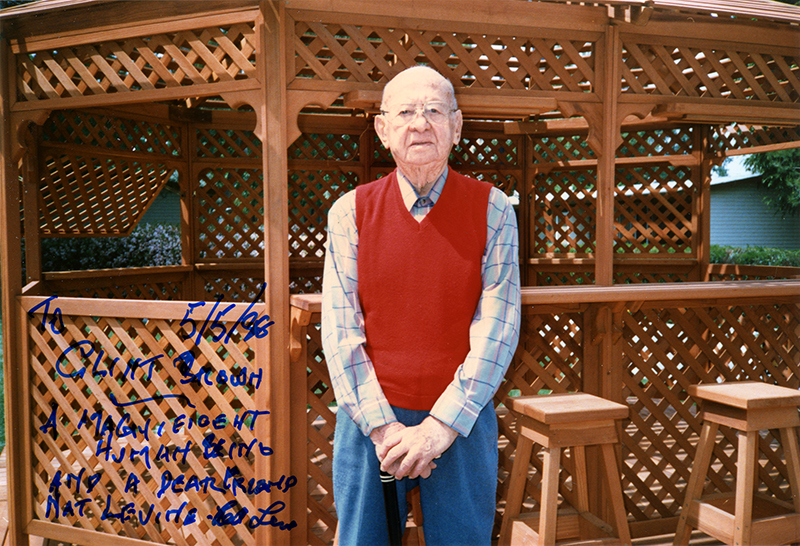Nat Levine
Mascot & Republic Film Producer

Click image to enlarge
| Download archival scan
About Nat Levine. It's not too big a stretch to say Nat Levine cut his movie-making teeth in Placerita Canyon. As one of the earliest producers to use the Newhall area on a consistent basis, he was important to the establishment of the Santa Clarita Valley as Hollywood's back lot. Nathaniel Levine got into the motion picture business at the very bottom in 1913 when he landed a job as an office boy to New York theater magnate Marcus Loew. Born July 26, 1899, Levine was just 14. Skipping high school, he worked his way up to Loew's personal secretary over the next six years. Then he headed West, stopping in Kansas City where he got into sales for a cartoon distributor. Among the clients was Walt Disney, who operated his first studio there. Realizing the real money was in the ownership and distribution of films, Levine completed his journey West to Hollywood in 1921. There, he purchased already-made films that had money troubles. Often the trouble was the money that was owed to Herbert Yates' film processing lab. Levine would cobble together the funds to buy the films, settle the debt, and more than recover his investment when he distributed them under the "states rights" system. In 1926-27, Levine got into producing his own pictures from scratch (which is why we can say he cut his movie MAKING teeth here). Stage work was done at the General Services rent-a-studio in Hollywood and the Mack Sennett Studios in L.A.'s Silver Lake district; locations varied from the Newhall area and Vasquez Rocks to the movie ranches in Chatsworth and Simi Valley. Levine teamed up with independent director Harry S. Webb and formed Mascot Pictures Corp., which became the king of the 12-chapter serial. The serials were guaranteed to keep audiences coming back week after week for the next chapter, which usually ran about 20 minutes. They were guaranteed to make money under the states rights system, too; how could a theater owner not buy the next chapter when the audience was expecting it? And when it ended after three months, another captivating Mascot chapter play would come along. Purt' near everybody who became anybody in the 1930s and '40s waltzed through a Mascot chapter play in the '20s and '30s — from the SCV's own Harry Carey Sr. ("The Vanishing Legion," "The Devil Horse") to stuntman extraordinaire Enos Edward "Yakima" Canutt (whose son Tap Canutt would later take up residence in Agua Dulce) to Glendale's Marion Morrison, aka John Wayne (who would star in many pictures in Placerita Canyon under Paul Malvern's Lone Star brand name), to a certain Western singer who couldn't rope or ride but wanted to try his hand at acting. The year was 1935, and it was actually Herbert Yates' idea. By this time, Yates had consolidated some of the little independent production companies — Mascot, Lone Star, M.H. Hoffman's Liberty Films and Trem Carr's Monogram Pictures — into a new iteration of Republic Pictures Corp., with Nat Levine in charge of Western and serial production. Yates wanted to try out his new singer on screen — and that's how Gene Autry ended up in a really weird Nat Levine chapter play called "The Phantom Empire." Autry is killed in Chapter 6, but fear not, dear audience: He comes back to life the following week. Next, Levine created the first Gene Autry Western, "Tumbling Tumbleweeds," filmed primarily at Carr's Placerita Canyon movie ranch, and the rest, as they say, is history. Not quite all Mascot actors were greenhorns. Levine scored a coup in 1935 when he landed an A-lister for his 15-chapter "The Miracle Rider." It was Tom Mix's last picture. Yates and Levine would have a falling out in 1938. By all accounts, Yates was a hard man to deal with. Levine reportedly walked away with more than $1 million ... which he promptly blew at the racetrack. Louis B. Mayer gave him a job at MGM, but it wasn't like the old days, and Levine finished out his career where he started, in a movie theater. He ran a picture house in Redondo Beach for 20 years. In the late 1960s, Levine retired to the Motion Picture Home in Woodland Hills. That is where we find him in this 4x6-inch color print which he has autographed to "Clint Brown, a magnificent human being and a dear friend." Sadly, we don't know who that is. If you know, please tell us in the comment section below. Levine has dated the photograph May 5, 1988. He died a little over a year later, on August 6, 1989. His final resting place is Valhalla Memorial Park in North Hollywood. — Leon Worden 2020 Further reading: Tuska, Jon. "The Vanishing Legion: A History of Mascot Pictures 1927-1938." Jefferson, N.C.: McFarland & Company Inc., 1982.
LW3725: 9600 dpi jpeg from original photograph purchased 2020 by Leon Worden.
|
